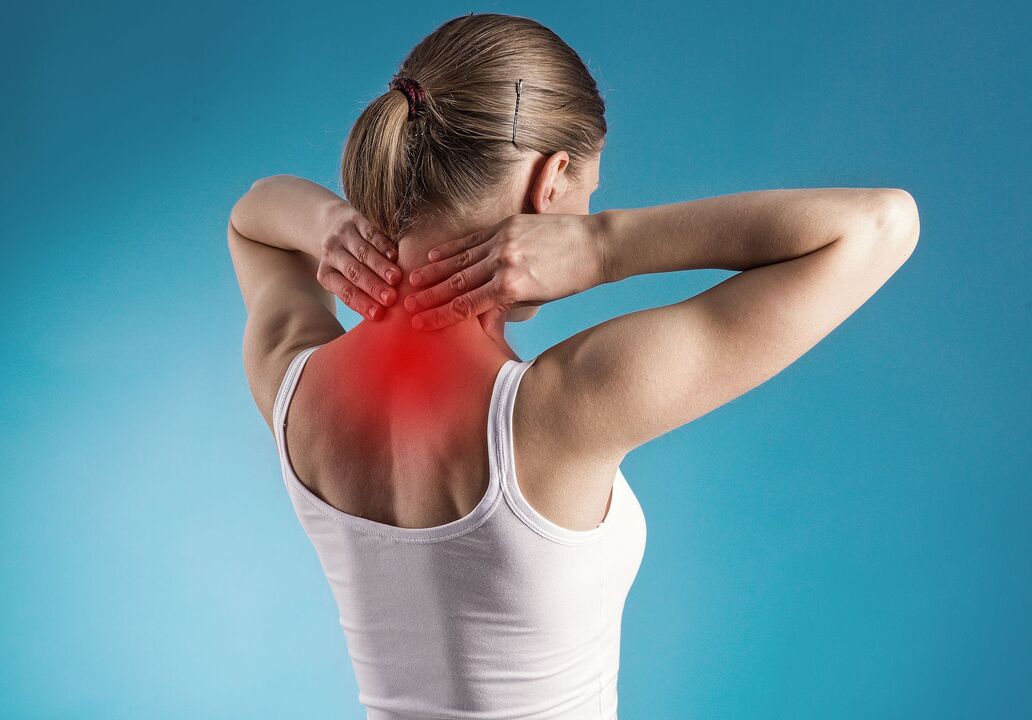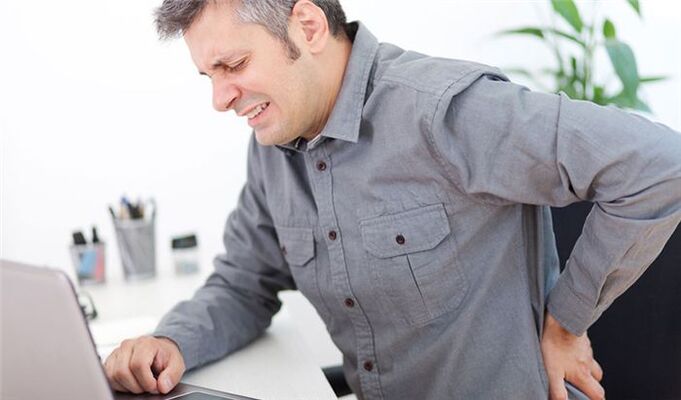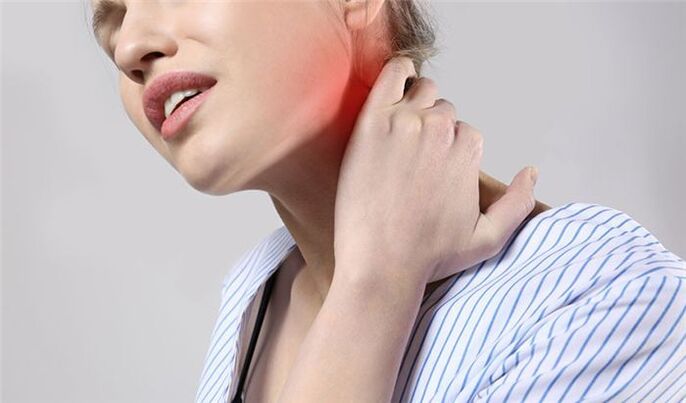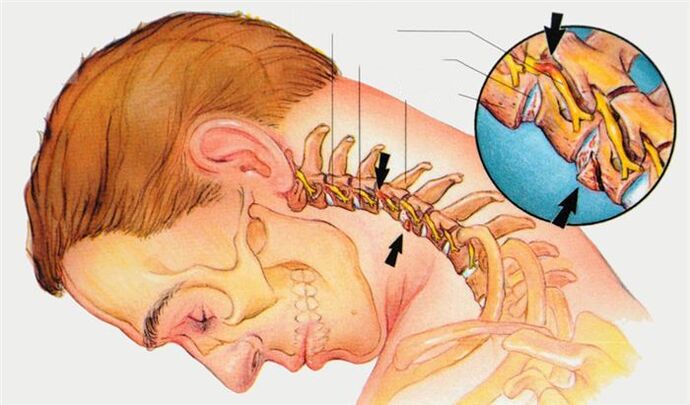
Existing methods of treating cervical osteochondrosis are aimed at reducing symptoms, preventing complications, stopping further destruction of the cartilage and bone tissue of the spine, and preventing the patient from becoming disabled.
Osteochondrosis is a pathological degenerative-destructive process that first captures the intervertebral disc, and then the vertebra itself.
It is necessary to treat osteochondrosis of the cervical region immediately after the appearance of the first signs of the disease.
Mechanisms for the development of osteochondrosis
The spine consists of the vertebrae and the intervertebral discs between them. The disc has a gel-like nucleus pulposus in the center surrounded by a dense fibrous ring at the periphery. The nucleus pulposus is hydrophilic - saturated with moisture and is characterized by high elasticity. The elastic properties of the intervertebral discs ensure cushioning and mobility of the spine.
In people over the age of 20, the intervertebral discs gradually begin to lose their elasticity. This is due to the obliteration of the vessels that supplied the intervertebral discs, and further blood supply occurs due to diffusion from the bodies of adjacent vertebrae. In the cartilage tissue, against the background of a lack of nutrients, regeneration processes slow down – the intervertebral disc begins to "age". First, the nucleus pulposus dehydrates, loses its elasticity, becomes flat, which increases the load on the fibrous ring. Microcracks, stress zones, fractures appear in the structure of the ring, delaminations on.
The degenerated disc bulges toward the spinal canal and irritates the nerve endings of pain receptors located on the posterior longitudinal ligament.
Features of the pathological process in cervical osteochondrosis are associated with the anatomical structure of this spine: different structure and size of the cervical vertebrae, tighter articulation in the intervertebral joints and underdeveloped muscular frame. With prolonged static loads on the cervical spine (work at the computer), weak muscles do not hold the head well, and the main load falls on the spine.
Treatment of cervical osteochondrosis in a specialized clinic is carried out using a unique technology based on a combination of manual therapy, electrophoresis and photodynamic laser therapy under the supervision of a doctor.
The main reasons leading to the development of osteochondrosis:
- Congenital or acquired anomalies of the spine.
- Natural aging processes of the body.
- genetic predisposition.
- Long-term static and dynamic overload of the spine: forced posture, hypodynamia.
- Passion for sports that endanger the spine: professional wrestling.
- Smoking.
- Autoimmune diseases with damage to connective tissue - collagenosis.
- Improper nutrition with predominantly carbohydrate and fatty foods, with a lack of proteins, vitamins, micro and macro elements.
- overweight, obesity.
- Injuries and diseases of the spine.
Osteochondrosis of the spine - is there such a diagnosis?
In English medicine, this term refers to a very different group of diseases that have nothing to do with our "native" osteochondrosis. In the International Classification of Diseases - a book that all neurologists should refer to when making a diagnosis -there are such terms as "adult spinal osteochondrosis", "juvenile spinal osteochondrosis", "spinal osteochondrosis, unspecified".
However, sometimes this diagnosis is not entirely justified, when in fact the doctor cannot fully find out what is happening to the patient. This term includes diseases such as:
- Myofascial Pain Syndrome- a condition in which there is a constant spasm in the same muscles.
- muscle injury.After an injury, the pains begin to bother, and after a while they pass on their own.
- otolithiasisA condition in which calcium salt crystals accumulate in the inner ear. They lead to dizziness - sometimes they are confused with a manifestation of diseases of the spine.
- Headache.They are also often associated with degenerative changes in the cervical spine. In fact, they often have other causes.
Take care of yourself, register now for a consultation without delaying treatment.
Treatment of osteochondrosis of the spine
The standard package of therapeutic measures to aggravate the disease looks like this:
- Anti-inflammatory and analgesic agents.The doctor may prescribe Voltaren, Movalis, Ibuprofen and other drugs.
- If the pain is very strong and does not go away- Use a novocaine blockade. The doctor, armed with a needle and syringe, injects an anesthetic into specific spots where it blocks the transmission of pain nerve impulses.
- Physiotherapy helps:Drug electrophoresis with novocaine, ultrasound, UV irradiation, diadynamic currents.
- If the pain keeps you on edge,Prescribe medication to help you calm down.
- To the pain areaapply dry heat.
- To relieve the spineDifferent types of traction are used. The patient can be placed on a special bed with a raised headboard and fixed with rings under the armpits. The underwater traction in the pool is also used.
- The doctor can recommendYou visit a chiropractor, acupuncture sessions.
- During an exacerbationWear special orthopedic devices that help relieve muscles and support the spine - corsets, shant collars.
When the exacerbation passes, you need to take measures that will help prevent a new one. Therapeutic exercises and massages strengthen the muscles that support the spine. Appoint courses of physiotherapy. Good for swimming. All methods of treatment for osteochondrosis have contraindications, they must be used wisely, so self-medication is not the best choice. Visit a doctor.
Sometimes, despite treatment, the symptoms of the disease continue to increase, the patient's condition worsens. In this case, the neurologist can raise the question of surgical treatment.

Why You Should See a Doctor Soon? First, "true" osteochondrosis is not such a harmless disease. Over time, if left untreated, it can render a person disabled. Second, the symptoms can be caused by the same myofascial pain syndrome - a neurologist can quickly identify the cause of the pain and eliminate it.
Back pain is a symptom that, according to statistics, more than 90% of people have experienced at least once in their lives. Most often it is attributed to osteochondrosis. Not all people with back pain go to the doctor. Many are treated on their own with drugs that are available in pharmacies without a prescription, folk remedies. Sometimes such "treatment" brings temporary relief - and in the meantime, the disease can continue to progress and maybe next time the back or lower back will "twist" a lot more.
An experienced neurologist can correctly assess the symptoms of osteochondrosis, understand their causes and prescribe the correct treatment for osteochondrosis.
With pain - the main manifestation of osteochondrosis - you can fight for a long time more or less successfully with the help of painkillers and anti-inflammatory drugs, some folk remedies. However, this does not solve the main problem, pathological changes in the spine continue to increase.
Over time, this is fraught with compression of the spinal cord and the arteries that feed it and the development of serious neurological complications: severe debilitation up to complete loss of movements and sensitivity, impaired control of the bladder and rectum.
Stages of development of cervical osteochondrosis
In its development, cervical osteochondrosis as a disease goes through several stages:
I direct. The initial phase is characterized by local pain in the neck, which is aggravated by turning and tilting the head. There is a smoothness of the cervical lordosis and muscle tension. Morphological changes begin in the structure of the intervertebral discs: desiccation of the nucleus pulposus, tears in the fibrous ring.
Stage II. Pain in the neck increases with irradiation of the arm and shoulder. In addition, there are severe headaches, weakness, reduced performance. The destruction of the fibrous ring continues, signs of pathological mobility and instability of the vertebrae appear.
Stage III. Pain in the neck is severe, constant, and radiates to the arms and shoulders. The muscles of the hands become weak, numbness of the upper limbs is noted. Patients have headaches, dizziness, disorientation in space. At this stage, the fibrous ring is completely destroyed. The gelatinous nucleus pulposus is not fixed, extends beyond the vertebrae and invades the spinal canal, forming a hernia. A hernia protrusion compresses the nerves and blood vessels, leading to reduced blood flow in the cervical spine.
IV stage. This is the final stage of the disease. The cartilage of the intervertebral discs is replaced by connective tissue, adjacent segments of the spine are involved in the pathological process. The joints grow together and become immobile (ankylosis). The patient's condition is serious: severe pain not only in the neck, but also in the arms, chest, between the shoulder blades, signs of a cerebrovascular accident, sensitivity disorders. This is a life-threatening condition that can lead to a stroke.
The success of the treatment depends to 90% on the experience and qualifications of the doctor.
diagnosis
Diagnosis of osteochondrosis of the cervical spine is made on the basis of: patient complaints, a characteristic clinical picture, anamnesis of the disease, data of a neurological and orthopedic examination of the patient using modern diagnostic methods: X-ray, magnetic and computer tomography , and the results of functional tests.
After an accurate diagnosis, the doctor decides how to treat osteochondrosis of the neck in this patient, which technique should be used in a particular case.
Treatment of osteochondrosis of the cervical spine
Cervical osteochondrosis is treated symptomatically, mainly by conservative methods, including:
- Drug therapy, which includes pain relievers, anti-inflammatory drugs, muscle relaxants, B vitamins.
- Physiotherapy methods: electrophoresis, laser therapy.
- Manual therapy.
- Acupuncture.
- Physical therapy.
Surgical intervention is performed extremely rarely when there is a real threat of developing a stroke, paralysis or injury to internal organs.
At this stage of the development of medical science, osteochondrosis of the cervical spine cannot be completely cured, but further progression of the pathological process can be prevented and the condition of the affected spinal segment can be stabilized.
An integrated approach, economical nature of the applied therapeutic methods allows you to effectively treat even advanced forms of cervical osteochondrosis.
The main methods of treatment of cervical osteochondrosis in a modern clinic
Manual therapy and osteopathy. This method of manual action on problem areas of the spine, the purpose of which is to restore the normal physiological position of the vertebrae and intervertebral discs. During the procedure, pinching of the nerve roots of the spine is eliminated, the neck muscles relax in the area of \u200b\u200bpathological changes.
Electrophoresis is a method of delivering medication directly to the area of the affected spinal segment. Prescribe drugs that improve blood circulation, reduce inflammation and muscle spasms.
Photodynamic phototherapy. The method is based on the ability of a light-sensitive preparation to be activated by laser radiation. In the area of \u200b\u200bthe affected segment, a layer of a drug is applied to the skin, which penetrates 10-13 cm deep into the tissues and has an anti-inflammatory and analgesic effect.
The author's three-component technique, including manual therapy, electrophoresis and laser therapy, allows you to quickly relieve pain, remove swelling of the surrounding tissues, improve blood supply in the area of \u200b\u200bthe inflammation and activate the metabolic processes of the damaged cartilaginous intervertebral discs. The goal of treatment is not only to relieve pain and improve the patient's condition, but also, acting on different parts of the pathological process, to stop further destruction of the intervertebral discs and the destruction of the vertebrae themselves.
The techniques used in modern clinics for the treatment of osteochondrosis of the neck have been tested in the best manual therapy centers in Europe and the USA, they are safe, effective, have practically no contraindications and are used well by patients even in older agetolerate groups.
Recommendations for dealing with cervical osteochondrosis are given to the patient after consultation with a neurologist, depending on the stage of the disease, the severity of symptoms, concomitant diseases and the results of examinations.
Osteochondrosis of the cervical region
Osteochondrosis of the neck is a degenerative disease, in which there is literally "premature aging", "wear and tear" of intervertebral discs, joints, vertebrae in the cervical spine.
Some facts about the disease:
- Osteochondrosis of the neck is about equally common in men and women.
- It most commonly affects people between the ages of 30 and 60.
- Pathology, as a rule, occurs in people who, at work, are constantly in the same position and have to perform monotonous movements.
- The cervical spine has some structural features, due to which the disease can have many different manifestations.

What features of the cervical spine cause the symptoms of osteochondrosis?
- There are openings in the lateral processes of the vertebrae - the carotid arteries, which supply blood to the brain, pass through them on the right and left.
- In the cervical region runs the initial part of the spinal cord - it contains fibers that carry nerve impulses to all parts of the body, providing movement and sensitivity. When there is compression of the spinal cord in the neck, neurological disorders occur throughout the body.
- This section of the spine has great mobility, which predisposes to the occurrence of osteochondrosis (although in most cases the disease still develops in the lumbar region - it not only has high mobility, but also experiences the greatest load).
- In the neck, nerve roots emerge from the intervertebral foramina and form the plexuses of the cervical and brachial nerves. They are responsible for movements in the muscles of the neck, arms, shoulder girdle, skin sensitivity and regulation of autonomic functions.
- The first vertebra does not have a massive anterior part - the body - it is a ring of bone that is placed on the tooth - a bone outgrowth on the second vertebra. This allows the head to be turned from side to side.
Neck pain, headache, weakness, numbness in hands are symptoms that should prompt you to consult a neurologist. Examination by a specialist and examination using modern equipment will help to understand the causes of the pathology and take the most effective measures.
What happens to the vertebrae in cervical osteochondrosis?
The incomprehensible medical term "degenerative process" refers to the following pathological changes that occur on the cervical spine:
- First of all, the lesion in osteochondrosis covers the intervertebral discs. They become thinner, reducing the distance between adjacent vertebrae. In their outer part, small gaps, microcracks are formed. Over time, this can lead to a herniated disc.
- Damage to the intervertebral discs disrupts the stability of the connection between the vertebrae.
- Suffer from osteochondrosis of the cervical and intervertebral joints - spondylarthrosis develops. It also promotes nerve root compression.
- The pathological process extends to the vertebrae themselves. Due to the fact that the functions of the intervertebral discs are impaired, their load increases. The spine tries to compensate for this injury, bone outgrowths - osteophytes appear on it.

Treatment of osteochondrosis of the cervical spine
During an exacerbation of osteochondrosis of the cervical vertebrae, traction is used (the patient is laid on a bed with a raised headboard and the head is fixed with a special loop) to relieve the pressure on the intervertebral discs. You must wear a shant collar for the same purpose. Painkillers and anti-inflammatory drugs are prescribed to relieve pain. With severe pain that does not go away, the doctor can perform a blockade: inject an anesthetic solution into the area of \u200b\u200bthe affected nerve roots. Physiotherapy is used: ultrasound treatment, electrophoresis with novocaine.
When the exacerbation subsides, the treatment of osteochondrosis of the cervical spine includes massage, physical therapy, physiotherapy.
One of the main signs of cervical osteochondrosis is neck pain. Many people, faced with this symptom, do not go to the doctor, preferring to treat "chondrosis" with home remedies. There are at least two good reasons to refuse self-treatment and see a specialist.
First, painkillers and folk methods, although they relieve pain for a while, do not solve the main problem. Pathological changes in the spine continue to increase. Over time, this threatens with more serious consequences. As far as an operation may be necessary.
Secondly, neck pain occurs not only with osteochondrosis. There are many other reasons. Only a doctor can understand and prescribe the right treatment.
physical therapy
Treatment of lumbar osteochondrosis is a long processrequire an integrated approach. Having eliminated the primary symptoms, you can proceed to the use of various physiotherapeutic procedures:
- UHF therapy.Exposure to radio frequency electromagnetic fields. It has an anti-inflammatory, analgesic effect and also promotes the start of regenerative processes.
- amplipulse.Low-frequency currents are applied to problem areas of the body. There is a dilation of blood vessels, which eliminates pain and spasms.
- phonophoresis and electrophoresis.The introduction of drugs into deep tissues using ultrasound and direct current.
Also widespread are massage procedures, which are possible only after eliminating the inflammatory process. Massage promotes muscle relaxation and eliminates spasms.
Diet - complex treatment of osteochondrosis
This disease requires a complex approach, so a change in diet is an absolutely effective method of treatment. Diet largely conforms to the generally accepted concept of healthy eating, so try to add the following types of foods to your diet:
- Citrus fruits (in the absence of allergies).
- Olive oil.
- Fresh herbs and vegetables.
- Mineral water.
- Fish and foods high in phosphorus, protein, magnesium and calcium.
- Milk and milkproducts.
An excellent tool is ready-made vitamin complexes, which can be found in a large assortment in pharmacy chains. Remember that all medications should be taken only as directed by a doctor.
What symptoms of osteochondrosis of the cervical spine should you take to the doctor?
The main symptom of cervical osteochondrosis is pain. It can appear in different places, depending on what level the pathological process is localized: in the neck, in the shoulder girdle, in the arm, in the heart region. By nature, the pain sensations are dull, can burn, hurt.
Other manifestations of the disease:
- Headache, dizziness, "flies in front of the eyes", noise, ringing in the ears.
- Weakness in the muscles of the neck, shoulder girdle, arms.
- Violation of the sensitivity of the skin.
- Shoulder-shoulder periarthritis: pain in the neck that spreads to the arm, difficulty extending the arm beyond 90°, weakness and atrophy of the muscles of the shoulder girdle.
- Shoulder-hand syndrome: shoulder and hand pain, swelling and stiffness of the fingers, weakness and atrophy of the hand muscles.
- Vertebral Artery Syndrome. Bony proliferation occurs on the vertebrae, compressing the nerves, resulting in a reflex spasm of the vertebral artery, which is involved in blood supply to the brain. The symptoms of cervical osteochondrosis are joined by constant headaches, starting from the back of the head and spreading to the temple to the crown, nausea, noise in the head, ringing in the ears, flickering of light spots in front of the eyes.
- Anterior scalene syndrome. On the neck there is an anterior and middle scalene muscle - they are located near each other, and between them there is a small space where nerves and blood vessels pass. In osteochondrosis of the cervical spine, the anterior scalene muscle tightens and compresses, causing symptoms such as pain in the inner surface of the forearm, shoulder, and fingers. Sometimes the pain radiates to the back of the head. The skin of the hand may become cold, pale, and numb.
- Epicondylitis Syndrome. In the lower part of the shoulder, on the sides of the elbow joint, there are bony protrusions - epicondyles. With epicondylitis syndrome caused by cervical osteochondrosis, there is pain that increases when pressed. Other symptoms also appear: pain in the neck, pain when pressing certain points in the area of the cervical spine.
If two sections of the spine are affected at the same time, then with cervicothoracic osteochondrosis, pain between the shoulder blades in the heart area may appear.
With osteochondrosis, the risk of intervertebral fracture and stroke increases. If you experience any of the symptoms listed above, contact your doctor.
Conclusion
Now you know how to treat osteochondrosis of the cervical spine without resorting to surgical intervention. Surgery is the most radical method of treatment when the disease is already running and there is no other way out. But it is within your power to do so in order not to bring your health to such a state.
































